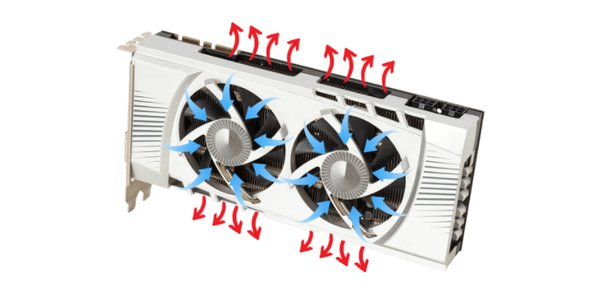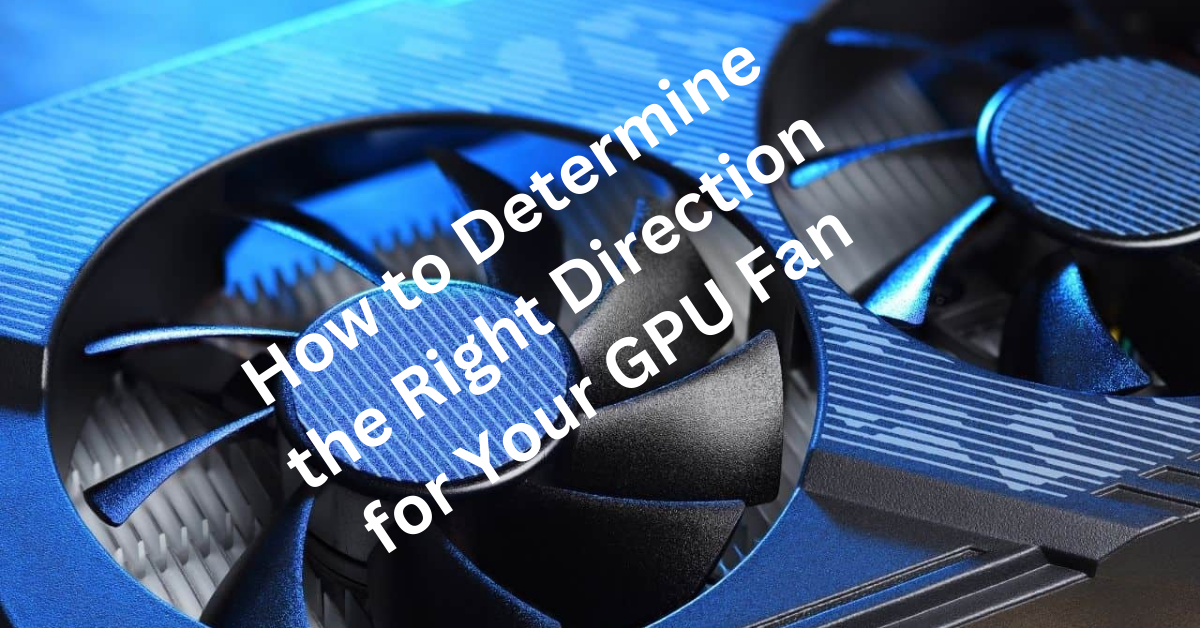Table of Contents
How to Determine the Right Direction for Your GPU Fan, GPU fans typically blow air outwards towards the back of the case, helping to expel heat generated by the graphics card. This orientation enhances overall system cooling and airflow efficiency
Introduction:
How to Determine the Right Direction for Your GPU Fan . Understanding the direction in which your GPU fan blows is crucial for maintaining an efficient cooling system in your computer. GPU fans are integral components designed to manage the heat produced by your graphics card during intense computing tasks.
Depending on the design of the fan, it can either blow air toward the GPU heatsink to facilitate cooling or push air out of the graphics card and through the computer case.Proper airflow direction ensures that your system’s cooling mechanisms work effectively, preventing overheating and maintaining peak performance. This guide will help you grasp how to determine your GPU fan’s airflow direction and why it’s essential for your computer’s overall health.
How do GPU Fans work?
Basic functionality:

A GPU fan operates by drawing cooler air from the surrounding environment and directing it over the GPU’s heatsink. The heatsink absorbs heat generated by the GPU, and the fan assists in transferring this heat away from the heatsink and into the surrounding air.
This ongoing process is vital for keeping your GPU within safe temperature limits and ensuring its efficient operation. Think of it as a reliable ally that helps maintain a comfortable temperature under pressure, similar to a fan on a hot day.
Types of GPU fan:
Axial Fans:
Axial fans are designed to push air directly across the heatsink, creating a focused airflow. This type of fan expels the warmed air out of the side of the graphics card.
Axial fans are effective for cooling because they provide a direct path for air to flow over the heatsink, helping to dissipate heat efficiently. Their design is often used in systems where the fan’s primary role is to enhance cooling by moving air across a specific area.
Blower fans:
Blower fans operate differently from axial fans. They push air through the graphics card and direct the warm air out of the back of the computer case. This setup is advantageous for maintaining a cooler internal case temperature since it expels warm air directly outside
Blower fans are beneficial in compact cases or systems where maintaining low internal temperatures is critical. They ensure that warm air doesn’t linger inside the case, which can help improve the overall cooling efficiency of the system.
Direction of GPU Fans:
Standard Fan Direction:
Typically, GPU fans are designed to blow air from inside the computer case out towards the back. This direction is intended to help expel the warm air generated by the GPU away from the card and out of the case.
By guiding warm air away from the GPU, this setup helps maintain a lower temperature for the graphics card and the internal components of the computer. It’s akin to creating a pathway to help dissipate heat and maintain a comfortable environment.
Reverse Fan Direction:
In some cases, the fan might be configured to blow air into the GPU. This reverse direction can be useful when additional cooling is required. For example, in high-performance or overclocked systems, blowing cooler air directly onto the GPU can enhance cooling efficiency.This setup is similar to having a fan blowing a refreshing breeze directly on you during a hot day, providing targeted cooling where it’s most needed.
Why Fan Direction Matters?
Heat Dissipation:
The direction of your GPU fan plays a critical role in effective heat dissipation. When the fan blows in the optimal direction, it helps to push warm air away from the GPU and out of the case.
This prevents heat from accumulating around the GPU, which can lead to overheating and reduced performance. Proper heat dissipation ensures that your GPU operates at its best, avoiding thermal throttling and potential damage. It’s comparable to ensuring a room is well-ventilated to keep the environment comfortable.
Airflow Optimization:
Optimizing airflow is crucial for maintaining a well-cooled system. When your GPU fan blows in the correct direction, it contributes to a smooth and efficient flow of air within the case. This balanced airflow prevents hotspots, ensures even cooling, and enhances overall system stability.
Effective airflow management is akin to a well-orchestrated dance, where each movement contributes to harmony and balance. It helps ensure that all components remain within their optimal temperature ranges, improving both performance and longevity.
How to Check Your GPU Fan Direction:
Visual Inspection:

Checking the direction of your GPU fan is a straightforward process. Most GPU fans have arrows on the side of the fan casing that indicate the direction of airflow. These arrows are a simple yet effective guide to help you verify that the fan is operating correctly. This visual inspection is as reassuring as finding a well-placed note that confirms everything is in order.
Using software:
Some graphic cards come with dedicated management software that allows you to adjust fan speed and directions. If your GPU supports such software, it provides a convenient way to fine-tune your cooling system without physically touching the hardware. This software can be likened to using a remote control to adjust settings effortlessly, ensuring your system stays cool and efficient.
Adjusting Fan Direction:
Manual Adjustments:
If your GPU fan design permits, you may be able to adjust its direction manually. This might involve physically repositioning the fan, which requires careful handling to avoid damage.
Adjusting the fan manually can fine-tune your cooling setup, similar to fine-tuning an instrument for optimal performance. Ensure you follow proper procedures and safety guidelines when making manual adjustments.
Using Software:
Some graphics cards come with dedicated management software that allows you to adjust fan speeds and directions. If your GPU supports such software, it provides a convenient way to fine-tune your cooling system without physically touching the hardware.This software can be likened to using a remote control to adjust settings effortlessly, ensuring your system stays cool and efficient.
Common Fan Issues:
Fan noise:

Unusual noises from your GPU fan can be a sign of underlying issues, such as dust buildup or mechanical problems. Dust and debris can obstruct the fan’s movement, leading to increased noise and reduced performance.
Regular maintenance and cleaning are essential to prevent these issues and ensure that your fan operates quietly and effectively. Persistent noise might also indicate a need for fan replacement or repair, so it’s important to address these concerns promptly.
Overheating:
If your GPU is overheating, it may be due to incorrect fan direction or insufficient airflow. Overheating can cause performance issues and potentially damage your hardware.
Addressing fan direction issues and ensuring adequate airflow are crucial steps to prevent overheating and maintain system stability. Just like addressing a problem before it escalates, promptly resolving cooling issues can help avoid long-term damage.
Maintenance Tips:
Regular Cleaning:
To keep your GPU fan performing optimally, regular cleaning is essential. Dust and debris can accumulate over time, obstructing airflow and reducing cooling efficiency. Cleaning your fan ensures that it continues to operate effectively, much like giving a fresh start to a well-used tool. Aim to clean your GPU fan every few months, or more frequently if you notice significant dust buildup.
Checking for Obstructions:
Ensure that there are no obstacles around the GPU fan that could block airflow. Proper spacing and ventilation are key to maintaining effective cooling. Regularly check the area around your GPU fan to ensure it remains clear and unobstructed. This preventive measure is akin to ensuring a path is clear for a smooth journey, allowing your cooling system to function at its best.
FAQs:
1. How can I tell if my GPU fan is blowing in the right direction?
Look for arrows on the side of the fan that indicate the direction of airflow. This visual guide will help you ensure your fan is operating correctly.
2. Can I change the direction of my GPU fan?
If your fan design permits, you can manually adjust its direction. Advanced GPU management software may also offer options for adjusting fan settings.
3. What should I do if my GPU fan is making a lot of noise?
Check for dust or debris and clean the fan. Persistent noise may indicate a mechanical issue, requiring a fan replacement.
4. How often should I clean my GPU fan?
Aim to clean your GPU fan every few months or more frequently if dust accumulates. Regular cleaning helps maintain optimal performance.
5. What are the signs that my GPU is overheating?
Signs include reduced performance, increased fan noise, and system crashes. Ensure proper airflow and check fan direction to address overheating issues.
Conclusion:
In conclusion, knowing your GPU fan’s direction is key to effective cooling and preventing overheating. Regular maintenance and proper airflow ensure your system runs efficiently and reliably. By staying on top of these details, you help maintain your computer’s performance and longetvity.

Patricia Tarka Only Fans Mega Link Folder